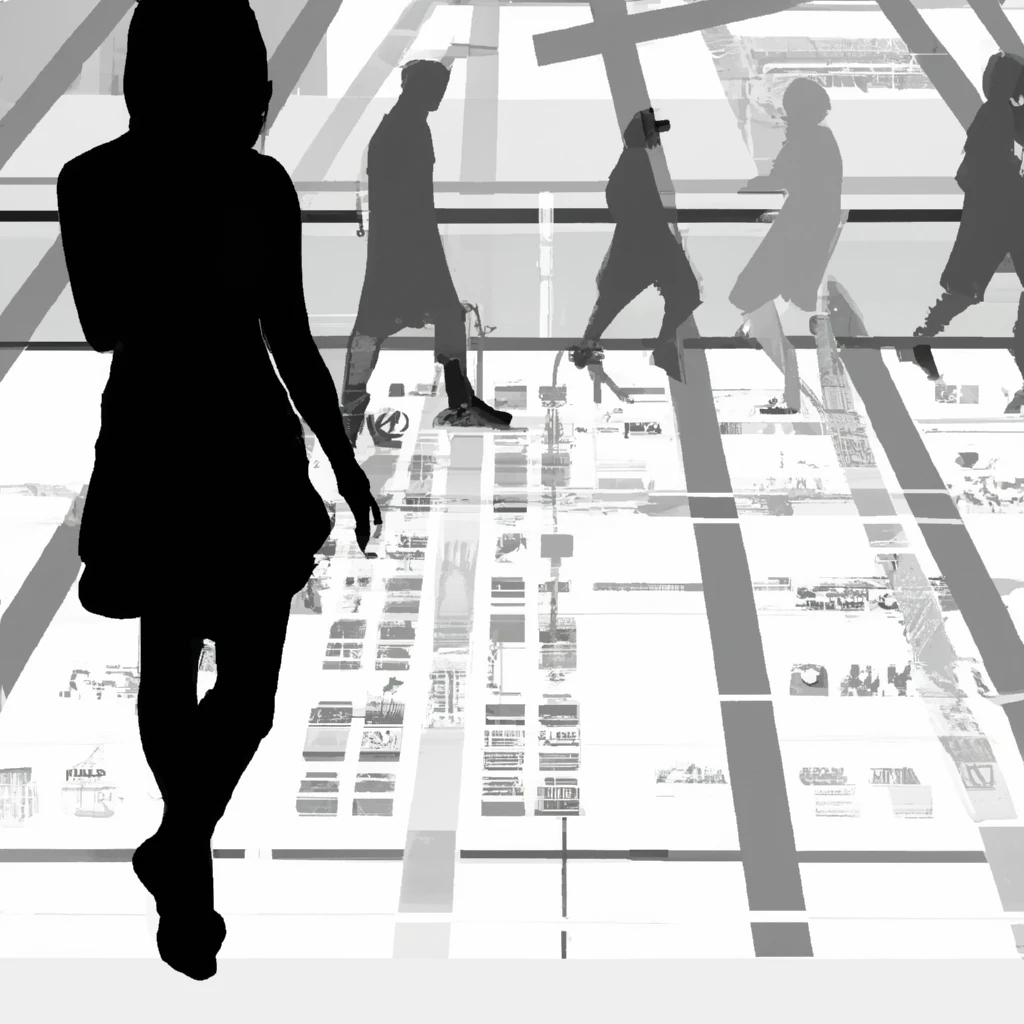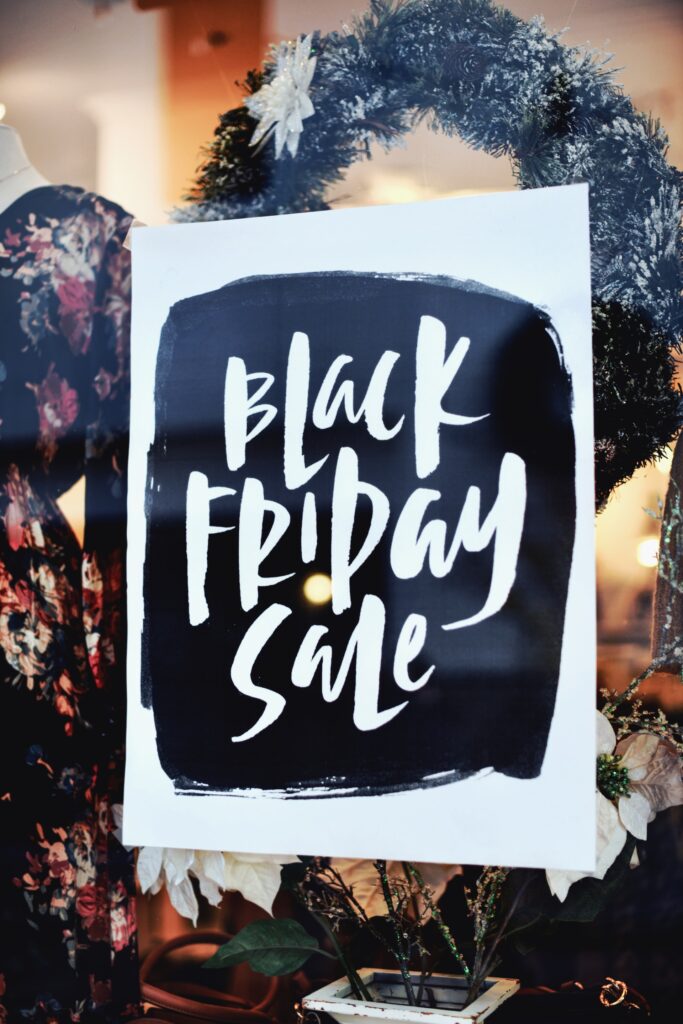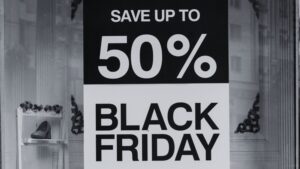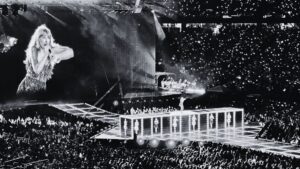Foot traffic data is essential to all retail stores. Understand what is driving traffic to adjust your store’s experience, store, and marketing strategy.
All of this data can be a lot to break down. Analyzing the data through reports, AI-powered insights, and raw data is how you can unlock a greater understanding of your customers and reach higher sales targets.
See our breakdown of what it is, how it works, and how you can increase it to boost your store’s sales.
At pass_by, we offer the highest in market accuracy with 94% correlation to ground truth, over 15 data inputs, and a full 90 days of predictive feeds. Book a call now.
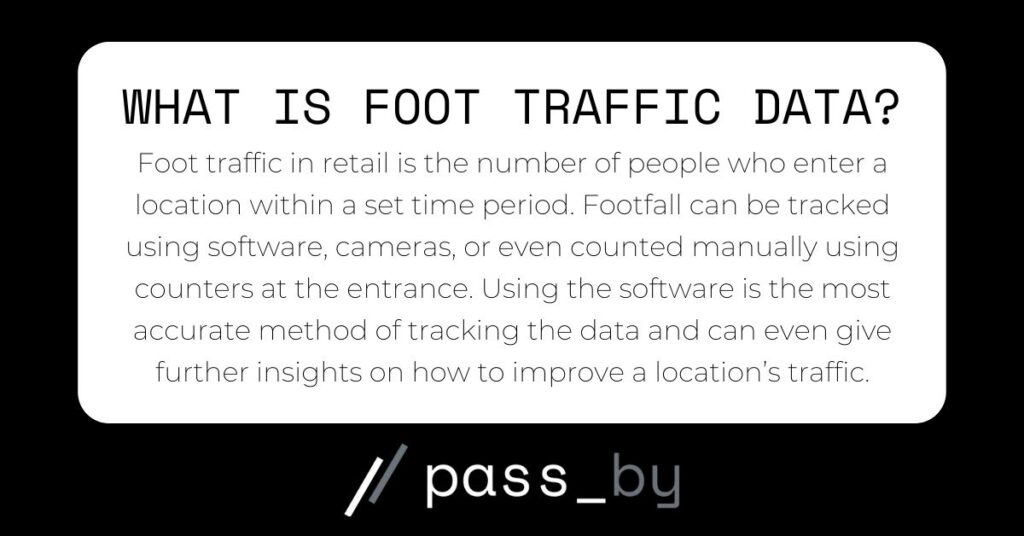
What is foot traffic?
Foot traffic in retail is the number of people who enter a location within a set time period. It is also commonly referred to as footfall.
Footfall can be tracked using software, cameras, or even counted manually using counters at the entrance. Using the software is the most accurate method of tracking the data and can even give further insights on how to improve a location’s traffic.
Foot traffic data can look like:
- Aggregated visits to a location: Data set where the number of visits to a location is aggregated, usually by time frame such as daily, weekly, or monthly.
- Individual visits to a location: Each visit is displayed with a timestamp to be organized and aggregated by the receiver.
- Characteristics of visitors at a location: Demographic datasets overlayed on location visits for insights on visitors in an anonymized report.
- Comparisons of visitors to a location: Compare two locations based on a target metric, such as age or dwell time.
How to get accurate foot traffic data for retail
Data collection can be done manually using hardware or digitally using automated software. In general, using software is the most accurate way to collect your store’s traffic data. Some providers also offer insights into your competitor’s footfall using retail analytics.
Retail foot traffic data is collected using a combination of:
- Sensors: Highly accurate hardware placed in entrances, including infrared beams and pressure mats.
- Cameras: Thermal or video cameras installed inside a retail store.
- Clickers: Foot traffic clicker counts used by staff members to manually count visitors.
- Wi-Fi and Bluetooth: Data collected from smartphone apps and devices when connected to a network.
- Purchase data: Determining the number of visits based on purchases.
- Aggregated data providers: Data from a provider uses many of the sources above, anonymized and aggregated, to comply with privacy laws.
At pass_by, we offer the highest in market accuracy with 94% correlation to ground truth, over 15 data inputs, and a full 90 days of predictive feeds. Book a call now.
How to calculate foot traffic data accurately
Foot traffic accuracy varies depending on the hardware and software used to collect it. For the best possible accuracy, it’s best practice to use multiple sources to confirm the number of visits.
For example, a store may install pressure mats, have a store app, and use a data provider to increase accuracy.
See our guide to foot traffic data providers for details on data sources and their accuracy.
The importance of accurate POIs in foot traffic data
POI (Point of interest) data is required for analysis. POIs tell you where visitors go with the highest frequency in your store. Important POIs include:
- Promotional or discount areas and displays
- New product displays
- Interactive experiences
- Changing rooms in a retail store
Without accurate POIs, analyzing where your customers are going and how many are engaged during their visit will be an uphill battle. Accurate Pois require stringent validation methods. When using a data provider and aggregator, look for validation methods and accuracy rates.
How much does foot traffic data cost?
How much the data costs varies depending on the data collection method, the service provider you choose, and the amount of data you will access. Chat with our team for more details to get the data you need at an affordable price.
How to analyze footfall data
Simply log on to your chosen platform and select the area you’re interested in analyzing. The platform will visualize the retail footfall data for you in three key ways:
- Foot traffic heat maps
- Area and competitor analysis
- Demographic data visualization
1. Foot traffic heat map
A heat map visualizes foot traffic data of a location, district, or region on a map to identify the most and least visited areas.
Using a foot traffic heat map can help businesses evaluate the street potential or performance of a location. For example:
- An area with low traffic may not be suitable for a new business.
- A store located in a high traffic area, but a low traffic store could have the potential for growth.
2. Area and competitor analysis
To analyze footfall data, an industry benchmark is needed. Find this data by logging onto your chosen platform that includes competitor analysis.
From there, select the area or store you want to compare and create a report. Then, you will see exactly where it ranks in comparison to its competitors. Our analysis also displays the number of visits, national ranking site ranking, and percentiles for easy benchmark creation.
3. Demographic and psychographic data
Understanding the characteristics of visitors is key to analyzing footfall data. Here’s a quick breakdown of how it works.
- Demographic data: Demographic characteristics including age, gender, and location.
- Psychographic data: Psychological characteristics including wants, hobbies and interests, lifestyle choices, and values.
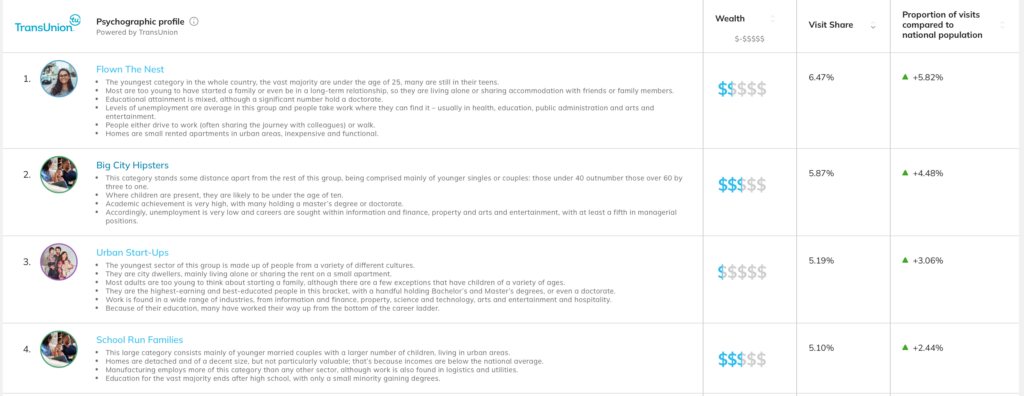
How to use foot traffic data
Once you’ve found the data you need, it’s time to put it to use and get actionable insights. Foot traffic data can be used to:
- Find or adjust retail store locations
- Check the results of marketing campaigns
- Competitor and market research
Find or adjust retail store locations
To find a new site, find out how to optimize your current locations, or make an informed decision on store closures, go through these steps.
1. Open a data platform such as Almanac.
2. View foot traffic statistics of the site and its competitors. This can give you an idea of if the site is underperforming, averaging, or surpassing its competitors.
3. Go to operating hours and see if visits align. This can tell you the best hours for business, so you can adjust your opening hours as needed.
4. Check the potential reach of the store. Zoom out on the map to see how far the reach goes – this shows how far visitors are traveling to visit your store. If reach is low, it may be worth reconsidering your retail marketing strategy.
Check the results of a marketing campaign
Successful marketing campaigns have an impact on foot traffic. You can measure the results of your campaign by:
- Logging on to the platform and going to your foot traffic data to see the number of visitors.
- Add competitors to the graph to see if any increase or decrease is unique to your business.
- You can also download this graph and share it with the wider marketing team.
Competitor and market research
Understanding the competition is imperative when you’re analyzing your performance within the sector, finding new tenants, or researching investment opportunities. To complete competitor research, follow these steps:
1. Log on to the data platform and go to trend data. This data shows you which brands are heading up or down. You can include multiple brands, such as your competitors, or partners.
2. See who’s leading in your region. Break down who the leaders are by location. Using our platform, you can sort by national, state, local, or custom level.
Foot traffic analysis is essential to understand your performance, potential, and impact of marketing campaigns. Try analyzing foot traffic now.
How to increase foot traffic examples
Footfall is key to increasing sales. There are many strategies to increase it and, depending on your location and business type, some will be more effective than others. Here’s the data on what methods can help.
1. Set expectations with industry benchmarks
Understanding the footfall in the area, what your competitors are experiencing, and historical performance can give you a better picture of what to expect.
Use a data platform such as Almanac to visualize the data. From here, you’ll be able to see seasonal performance and potential traffic. This can give you a benchmark of performance for all other steps.
2. Improve window displays
Store window displays can increase traffic, improve customer perceptions, boost impressions, and increase sales when done well.
- Ensure the customer can see through the display inside the store.
- Display trending items.
- Consider including promotional offers.
- Advertise loyalty schemes or rewards for shopping in-store.
- Get creative with seasonal, promotional, or themed displays to stand out.
3. Consider a mobile app
Having a mobile app can increase foot traffic and sales. The Starbucks mobile app accounts for 27% of total in-store sales, driven by their growing rewards scheme.
Apps can be used to alert nearby customers of events and offers. In the app, you can also promote in-store offers to reward loyal customers and increase footfall.
4. Have an event
In brick-and-mortar retail stores, events make the shopping experience special for consumers. Think about why customers should visit your store.
Yes, you could have great deals, great displays, and be in a good location, but how do you make it so your store is the first one that comes to mind? How do you get people to go out of their way to visit your location?
Make an event. This gives customers are reason to visit and gives them something extra to do, for example:
- Workshops
- Hosting a local group meetup
- Networking event
- Guest speaker
- Freebies for shopping in-store
- Competition or quiz
5. Improve the in-store experience
This means making sure your store is clean and well-organized, and that your staff is friendly and helpful.
You may also want to consider adding features like free Wi-Fi, a coffee bar, or even a kids’ play area.
6. Offer exclusive discounts
The power of exclusive discounts in attracting more foot traffic to your retail store can not be overstated. More than just a marketing gimmick, they provide a compelling reason for new and returning customers to step into your store (both physical and digital), simultaneously enhancing your brand’s market share and customer loyalty.
7. Use your social media presence
A retail marketing strategy that includes social media platforms is crucial these days to increasing foot traffic. By using social media effectively, you can reach a wider audience, generate interest in their products and services, and drive foot traffic to where you need it to be.
For example, a clothing store could run a social media contest where they give away a gift certificate to one lucky winner. To enter the contest, customers would need to follow the clothing store on the social platform, tag a friend in the comments of the contest post, and like the post.
8. Network and partner with other local businesses
Networking and partnering with other local businesses is a way to increase traffic to your retail store and improve brand recognition.
When you collaborate with other businesses in your community, you gain exposure to their customer base, and they, in turn, gain access to yours. This can lead to a significant increase in visibility and foot traffic for all parties involved. There are 3 main ways to achieve this:
- Cross-promotion: Offer discounts to each other’s customers, hand out flyers or coupons for each other’s businesses, or simply mention each other in your marketing materials.
- Joint events: Co-host a product launch, host a workshop or seminar together or even just have a joint happy hour or social event. Joint events are a great way to get people into your store and introduce them to other local businesses that they may not be aware of.
- Partnerships: In some cases, it may make sense to form a more formal partnership with another local business. This could involve things like co-branding products or services, offering joint discounts, or even sharing resources like staff or equipment. Partnerships can be a great way to leverage the strengths of both businesses and create a more compelling offering for customers.
How to convert foot traffic to sales
Now that you understand the importance of increasing foot traffic, it’s equally crucial to focus on converting that traffic into actual sales.
It’s not just about getting more customers into your store but making sure those visits turn into buying decisions. This process involves both art and science, and we’ve got some tested strategies to help you get a slice of this retail success.
1. Optimize the store layout
Once you’ve prepared your strategy to increase footfall, it’s time to ensure your store is ready to take advantage of that increase. If your store isn’t optimized, you could miss out on sales every single day.
One of the most popular ways to optimize a store is strategic product placement. This well-tested retail method puts seasonal and new products at the front of the store to catch attention. Optimized stores also put appealing products within eye-level on the shelves.
While strategic product placement is important, don’t forget your basics either! The store should be easy to navigate with clear signage and have pleasant lighting.
2. Push your digital store
We’ve mostly been talking about brick-and-mortar retail stores, but even these can have an online store as well.
Having an online store lets you pick up sales regardless of the weather, which can decrease sales in a brick-and-mortar store.
You may bring in a customer to your brick-and-mortar store and, for whatever reason, they don’t make a sale that day. They may need to wait until their paycheck arrives, need more time to make a decision, or want to look online for a different deal before making a purchase.
Understanding consumer buying behavior may help you see the types of consumers and how you can help them make a decision to buy.
A store visitor could decide to make a sale another day if a convenient option is there for them. To make sure you don’t miss out on these sales, you can:
- Give out business cards with your website and social media handles.
- Include online discounts and deals, sent out via text, email, and social media to customers.
3. Make it urgent
No one wants to miss out on a good deal! Including a sense of urgency, such as limited time offers, has a much better chance of closing a sale.
A sense of urgency can be made by:
- Displaying promotional signs in bright colors, arrows, percent of discounts, and how long the offer lasts.
- Posting about the limited time offer online, perhaps including a countdown until the deal is over.
- Sending an email about the offer.
- Training staff to remind the customer about the limited time offer and to provide information on the product.
4. Make it easy to buy
The more barriers in place, the less likely a customer is to cross that finish line and buy your product. The easier it is to buy, the better.
You can make the decision to buy easier by offering a variety of payment methods such as cash, credit, debit, buy now pay later, contactless, and app payments.
Buy now, pay later is one of the significant trends in retail in the past few years. Staying up to date with market trends can give your business an edge by being an early adopter.
How to find foot traffic data
Geospatial intelligence platforms and location data services offer retail foot traffic data from many sources, including mobile networks, to provide insight into any location for multiple sectors.
When looking for foot traffic data, it’s important to choose an option that has accurate data that respects consumer privacy. Here’s our VP of Product Matthew Taaffe explaining our data sources in a webinair with our partners Dewey:
pass_by foot traffic data sourcesWhen looking to purchase foot traffic data, you’ll come across two options:
- Receive the data in its raw form. This way, you’ll get the data to download and analyze yourself. This can be useful if you want to do your own analysis.
- Choose a platform. Opt for analysis and reports along with the data for clear visualization of the data. This is best if the chosen platform offers high accuracy, predictive data, and clear insights.
To receive accurate and relevant data, follow these steps:
- Sign up for a reputable intelligence platform or service
- Open the foot traffic data using the platform or your cloud provider
- Filter the data as needed for your requirements
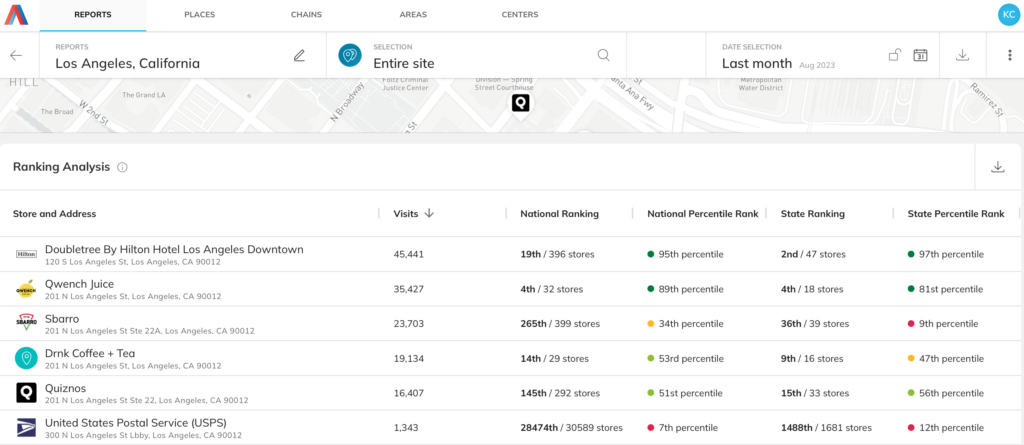
At pass_by, we offer the highest in market accuracy with 94% correlation to ground truth, over 15 data inputs, and a full 90 days of predictive feeds. Book a call now.
Finding foot traffic data that complies with privacy laws
Location data is valuable information, but consumer privacy must be respected. Some regulations to be aware of concerning the collection and storage of location data of this kind are:
- European Union’s General Data Protection Regulation (GDPR)
- California Consumer Privacy Act (CCPA)
We’ve adapted our practices accordingly to keep up with privacy regulation changes. Naturally, public opinion on location intelligence is a factor that is always on our radar, but that’s where pass_by’s commitment to transparency comes in.
We maintain no record of personal data. Demographic insights are provided by external data sources, and when attributed to geo-hits from mobile devices, provide a macro-level understanding of consumer behavior. See our private policy for further details.
Foot traffic data FAQs
What businesses get the most retail foot traffic?
According to a report by GasBuddy and Cuebiq, Speedway, Costco, Thorntons and Ricker’s have the most traffic. To get an accurate picture of what businesses are driving traffic and how your competitors are faring, use our foot traffic tool which has more than 5 years’ worth of historical data.
How do retail stores track foot traffic data?
Retail stores can track foot traffic with manual and digital tools such as counters, video cameras, mobile location tracking, Wi-Fi networks, and sensors.
What businesses collect retail foot traffic data?
Any business with a physical store can make use of foot traffic information. This includes:
- Retailers
- Finance companies
- Hospitality sector
- Mall owners, operators, and businesses within the mall
What is POI data?
POI (Point of Interest) refers to a place in the real-world such as a grocery shop, supermarket, park, or restaurant.
The location can be permanent such as a civil building or temporary like a pop-up shop.
POIs are used when analyzing foot traffic to identify specific locations.


